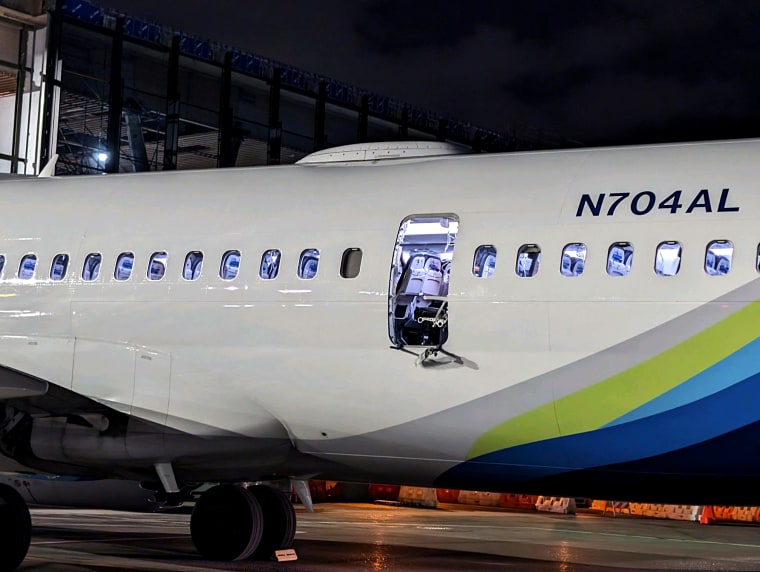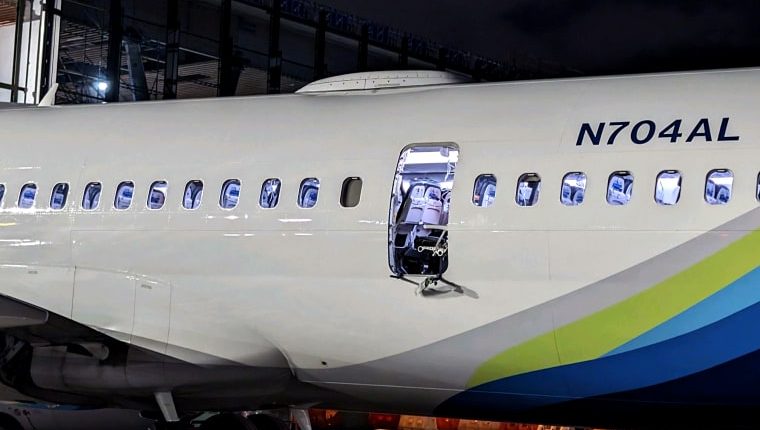A missing door plug that could be key to the investigation into what caused it to detach from a plane midflight Friday has been found in the backyard of a Portland, Oregon-area resident, officials said Sunday.
After the end of a news conference in which National Transportation Safety Board Chair Jennifer Homendy laid out the probe’s status, she returned to give a piece of positive news: “I’m excited to announce that we found the door plug,” she said.
Identifying the resident who sent two photos of the item to the NTSB only as Bob, a schoolteacher, she said, “Thank you, Bob.”
“We’re going to go pick that up and make sure that we begin analyzing it,” Homendy said.
At the end of the first full day of the NTSB investigation into the accident on board Alaska Airlines Flight 1282, the agency’s chair indicated that some factors were complicating the probe: The plane’s cockpit voice recorder’s record of the event was inadvertently taped over, and, at the time, the door plug had not been found.
“That is unfortunately a loss for us,” Homendy said, lamenting the loss of voice data and sounding frustrated during a news conference Sunday night. “That is a loss for safety.”

Homendy supports expanding the minimum time recorded on the devices from two hours to 25 hours. Such a time span would have saved the cockpit voice data from Friday’s accident.
She said the device from Friday’s flight automatically recorded over the pertinent voice data because someone failed to power it down. It starts a fresh recording, wiping out the last one, every two hours.
“The circuit breaker was not pulled,” Homendy said.
‘They heard a bang’
She described chaos and communication issues on board the Boeing 737 Max 9 as flight crew reported hearing a loud noise and the cabin rapidly depressurized Friday evening over the Portland area.
“They heard a bang,” she said.
The plane’s first officer lost her headset in the depressurization, and the captain had headset problems, as well, Homendy said. So they turned on a speaker for communication, she said.
“Communication was a serious issue,” Homendy said.
At the same time, the cockpit door opened violently, and a laminated emergency checklist pilots use in just such a situation flew out, the chair said.
“It did blew open during the explosive decompression,” Homendy said of the cockpit door.
The pilots turned to another reference guide, a handbook, she said, as a flight attendant took three tries to shut the cockpit door.
“The actions of the flight crew were really incredible,” Homendy said. “It was very violent when the door was expelled out of the plane. There was a lot going on.”
Homendy said the situation could have been far more dire had the plane been at cruising altitude, about 35,000 feet.
Earlier Sunday she spoke to NBC News about task ahead for NTSB investigators and said the “stakes are high.”
The Federal Aviation Administration has ordered some Boeing 737 Max 9 airplanes, the model flown in the Alaska Airlines incident, to be grounded and issued a directive requiring inspections before certain aircraft can fly again. The new directive affects 171 planes worldwide.
During Sunday night’s news conference, Homendy described some of the damage inside the plane. It included two seats, unoccupied by chance, that sustained such violent force that their frames had “torqued.”
Both seats in row 26 were missing their headrests, and one was missing a seat back. In all, damage was found along 12 of the plane’s seat rows, Homendy said.
She expressed concern over three babies who were held in the laps of their caregivers. The NTSB, the FAA and Alaska Airlines all recommend, but don’t require, that young children travel in car seats secured in separate, ticketed seats.
Analyzing the door plug
Investigators are looking at how the door plug — a panel where an optional emergency exit can be placed depending on passenger capacity — was fastened before it blew out of the plane, Homendy said.
They also want to know more about air pressurization alerts that went off on the plane during flights on Dec. 7 and on Wednesday and Thursday, the latter being the days before the accident.
She said the airline prohibited the aircraft from embarking on long flights over water — specifically from traveling to Hawaii — until the issue could be checked out more thoroughly. By Friday night’s flight from Portland to Ontario, California, that inspection hadn’t been completed, Homendy said.
She said the issue had been described to the NTSB has “benign” and that it was unclear whether there was any correlation between those alerts and Friday’s accident.
Homendy said investigators were focused in part on how the door plug was fastened and whether there were failures related to it, although she said the structural integrity of the aircraft was intact following the accident.
She described two hinges at the bottom of the plug that allow a small degree of opening for routine inspections as well as four “stop fittings” in the shape of circles.
“The purpose is to prevent that door plug from being pushed out of the air frame,” she said.
All those elements were going to get a close look, Homendy said.
Source: | This article originally belongs to Nbcnews.com









